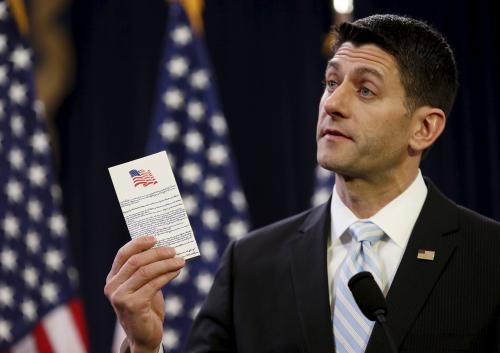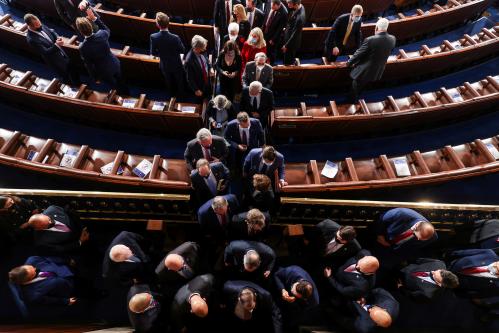The 2018 midterm elections are now less than a year away, and some analysts have begun to explore whether Democrats are well-positioned to take advantage of a potential wave election. If Republicans maintain their majority in the House, however, it will be without at least four of their 21 current committee chairs. Three—Reps. Bob Goodlatte (R-Va.), Jeb Hensarling (R-Tex.), and Lamar Smith (R-Tex.)—have announced they are retiring at the end of this term. A fourth, Rep. Diane Black of Tennessee, is running for her state’s governorship.
Importantly, Republicans would be replacing Goodlatte, Hensarling, and Smith at the helm of the Judiciary, Financial Services, and Science Committees, respectively, even if they weren’t retiring, thanks to term limits on committee chairs and ranking members imposed by House Republicans. Since 1992, House Republican conference rules have restricted members to three consecutive terms in top committee leadership roles. When Republicans took control of the chamber at the start of 104th Congress in 1995, they incorporated the limitation into the full House rules, where it has generally remained; the only exception is that Democrats removed it while they controlled the chamber in 2009 and 2010.
As we can see in Figure 1 below, the existence of these term limits appears to have affected retirement patterns. Since the 96th Congress (1979-1980), an average of roughly 10 percent of committee chairs have retired at the end of each congress. (“Retire” here is defined as leaving the chamber as an exit from politics entirely and does not include departures to run for other office, deaths, etc.) Congresses in which the rules would not force any chairs to step down appear in red, with an average of approximately 8.6 percent of chairs retiring. Congresses where the rules might have affected behavior, meanwhile, appear in blue, with roughly 12.3 percent of chairs leaving the chamber each Congress.
Figure 2 examines how Republicans specifically have tended to respond to the presence of term limits. Of the 55 Republicans that have been term-limited out of committee chair or ranking member positions, 19 have chosen to retire when their leadership posts were expiring. In 2000, when the first class of Republican chairs affecting by the limits were running for re-election, one-third departed. In more recent years (2014, 2016, and 2018), however, that number has been higher, topping 40 percent.
What might the consequences of term limits for committee leaders be? Using data from their ongoing research on legislative effectiveness, political scientists Alan Wiseman and Craig Volden have documented how committee chairs’ effectiveness generally increased with the length of their service in such positions between 1973 and 2014. For the first three terms of service, Republican and Democratic chairs were roughly equal in their effectiveness, but Democratic chairs who served four or more terms saw their effectiveness increase at a greater rate over the later part of the their terms. Republican chairs, as a result, were, on average, less effective than their Democratic counterparts who served longer terms. In addition, the average effectiveness of chairs declined over time. The average chair in the 113th Congress (2013-2014) was roughly half as effective the average chair in the 93rd Congress (1973-1974). While broader changes in the institution, especially the centralization of power in the hands of party leaders, likely also contributed to this change, the potential effect of the changing institutional rules can’t be ignored.
While service as a committee chair may not be associated with as much influence over legislation as it once was, Republican committee chairs are still more effective relative to their same party, non-chair peers. Since the 104th Congress, roughly two-thirds of Republican committee chairs have scored higher than their average fellow Republican who has served the same number of terms.
Importantly, however, these benefits don’t appear to stick with those members who do choose to remain in the chamber when their chairmanships end. Between the 106th and 112th Congresses, 23 Republicans chose to continue serving after being term-limited out of a committee leadership post. Of these, six proceeded immediately to lead a different committee. But of the 17 who remained as rank-and-file members, 12 were less effective than their average fellow party member in the next Congress. The effectiveness benefits of being a committee chair do not necessarily follow a member into his or her future service.
Imposing term limits, then, may be a double whammy. As Wiseman and Volden demonstrate, committee chairs aren’t as effective as they once were. To the extent that members choose to stay in the chamber when they are term-limited, they tend to see their effectiveness go the way of their leadership posts. Certainly, term limits may have value in some contexts; Democrats, for example, are grappling with frustration among some of their rank-and-file about the lack of upward mobility that results from the absence of restrictions on committee leadership service on their side of the aisle. But if we are to take seriously the consequences of House retirements, term limits for committee chairs, and how they affect Republicans’ choices, should be considered a key part of the story.
The Brookings Institution is committed to quality, independence, and impact.
We are supported by a diverse array of funders. In line with our values and policies, each Brookings publication represents the sole views of its author(s).











Commentary
Retirement from Congress may be driven by term limits on committee chairs
November 30, 2017